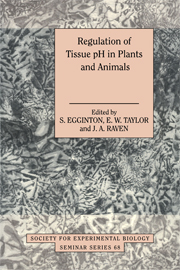Book contents
- Frontmatter
- Contents
- List of contributors
- Preface
- Measurement of intracellular pH: a comparison between ion-sensitive microelectrodes and fluorescent dyes
- pH-sensitive microelectrodes: how to use them in plant cells
- The use of nuclear magnetic resonance for examining pH in living systems
- Invasive studies of intracellular acid–base parameters: quantitative analyses during environmental and functional stress
- Lactate, H+ and ammonia transport and distribution in rainbow trout white muscle after exhaustive exercise
- Limiting factors for acid–base regulation in fish: branchial transfer capacity versus diffusive loss of acid–base relevant ions
- H+-mediated control of ion channels in guard cells of higher plants
- pH regulation of plants with CO2-concentrating mechanisms
- Intracellular pH regulation in plants under anoxia
- The role of turtle shell in acid–base buffering
- Acid–base regulation in crustaceans: the role of bicarbonate ions
- A novel role for the gut of seawater teleosts in acid–base balance
- pH and smooth muscle: regulation and functional effects
- Regulation of pH in vertebrate red blood cells
- Acid–base regulation in hibernation and aestivation
- Hepatic metabolism and pH in starvation and refeeding
- Back to basics: a plea for a fundamental reappraisal of the representation of acidity and basicity in biological solutions
- Index
pH and smooth muscle: regulation and functional effects
Published online by Cambridge University Press: 22 August 2009
- Frontmatter
- Contents
- List of contributors
- Preface
- Measurement of intracellular pH: a comparison between ion-sensitive microelectrodes and fluorescent dyes
- pH-sensitive microelectrodes: how to use them in plant cells
- The use of nuclear magnetic resonance for examining pH in living systems
- Invasive studies of intracellular acid–base parameters: quantitative analyses during environmental and functional stress
- Lactate, H+ and ammonia transport and distribution in rainbow trout white muscle after exhaustive exercise
- Limiting factors for acid–base regulation in fish: branchial transfer capacity versus diffusive loss of acid–base relevant ions
- H+-mediated control of ion channels in guard cells of higher plants
- pH regulation of plants with CO2-concentrating mechanisms
- Intracellular pH regulation in plants under anoxia
- The role of turtle shell in acid–base buffering
- Acid–base regulation in crustaceans: the role of bicarbonate ions
- A novel role for the gut of seawater teleosts in acid–base balance
- pH and smooth muscle: regulation and functional effects
- Regulation of pH in vertebrate red blood cells
- Acid–base regulation in hibernation and aestivation
- Hepatic metabolism and pH in starvation and refeeding
- Back to basics: a plea for a fundamental reappraisal of the representation of acidity and basicity in biological solutions
- Index
Summary
Introduction
Smooth muscle is found within the walls of hollow organs and tubes of the body such as the uterus, stomach, ureter and blood vessels. Its main function is to move liquids or objects through these tubes, which it does by altering its contractile state. Its correct functioning is therefore vital to many activities, for example breathing, reproductive ability, voiding urine and controlling blood pressure. The control of the contraction of smooth muscle is accomplished by neuronal, hormonal and local mechanisms. This chapter focuses on one such local mediator – pH – and considers how pH may be altered by normal and pathological processes. Given its potent ability to modify smooth muscle contractile activity, it is clearly necessary that pH is regulated. Therefore, what is known about this process in smooth muscle is discussed, and how changes in pH affect contractility is described.
Techniques used to measure pH in smooth muscles
Measurement of extracellular pH (pHe) in smooth muscles is generally straightforward. In single cell studies or perfused organs pHe will be that of the perfusate. This is usually 7.4, to match that of plasma. For measurement of surface pH, microelectrodes can be placed against the cell or tissue (Thomas, 1984).
The measurement of intracellular pH (pHi) in smooth muscle has now become routine, mainly because of the development of pH-sensitive fluorescent indicators. The small size of smooth muscle cells coupled with their contractile nature had largely prevented the successful use of pH-sensitive microelectrodes (Aickin, 1984).
- Type
- Chapter
- Information
- Regulation of Tissue pH in Plants and AnimalsA Reappraisal of Current Techniques, pp. 275 - 298Publisher: Cambridge University PressPrint publication year: 1999



